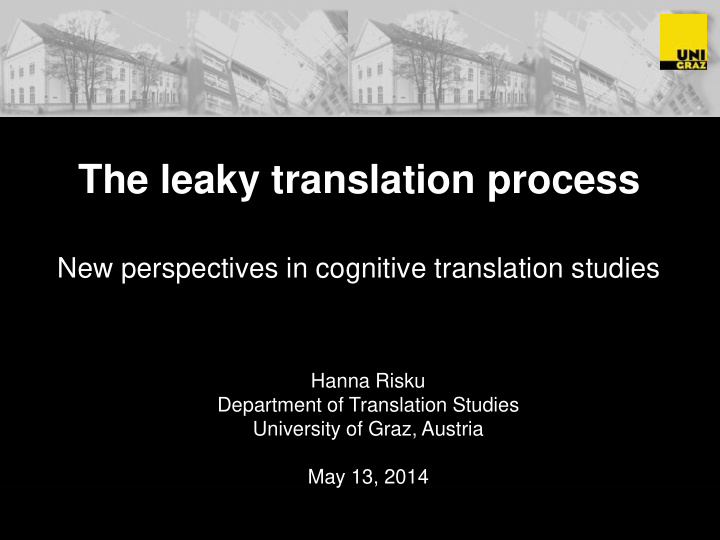



The leaky translation process New perspectives in cognitive translation studies Hanna Risku Department of Translation Studies University of Graz, Austria May 13, 2014
Contents 1. Goals and methodological development of the study of cognition in translation 2. Research design and results of a field study 1. Translator activities 2. Externalization and interaction 3. Iterative operation patterns 3. 10 hypotheses: new perspectives in cognitive translation studies
Project Extended translation: Socio-cognitive translation processes in the workplace (ExTra) Translation: Cognition and Cooperation (TCC) Research Group, Department of Translation Studies, University of Graz, Austria 2014 - 2017
Cognitive Translation Studies • Modeling translation-relevant cognitive processes • Understanding how translations are produced • Identifying main factors and their correlations
“ A broad outline of Translator Studies would cover sociology, culture and cognition, all looking at the translator’s agency, in different ways. ” Chesterman 2009:13
Main methodological approaches to date • EEG brain activity measurements (Kurz) • “Thinking aloud” (Krings, Lörscher, Jääskeläinen, Tirkkonen, Kußmaul) • Retrospection (Hansen, Englund Dimitrova & Tiselius) • Tracking/logging of translation process on computer screen (Jakobsen, Schou et al.) • Eye-tracking (Dragsted, Shreve, Lacruz, Angelone, Rüdning, Lachaud, O´Brien) • …Triangulation
The experimental approach • Defining the variables • Hypothesizing a correlation between them • Manipulating a particular variable • Establishing an experimental sample and a control sample • Involving a sufficient amount of data in order to test the hypothesis • Controlling the confounding variables • In laboratory settings
Situated Cognition The brain as a part of a network Mind Body Environment
Situated Cognition The brain as part of a network input output
The ethnographic approach • Perspective of the participants • Authentic situations of action • Construction of meaningful action by the participants • Structuring of the research object by the participants • Factors identified through empirical research • Research object: incl. unknown factors
Symbol Manipulation The brain as a computer
Symbol Manipulation The brain as a computer output input
Symbol Manipulation The brain as a computer 3+2+10:6-9 = ? E = mc 2 Man = Human\Woman
Connectionism The brain as a network input output
Connectionism The brain as a network Pattern Recognition
Situated Cognition The brain as part of a network
Situated Cognition The brain as part of a network
Artefacts
Information and media infrastructures
Architecture and spatial/geographic context
Biological and ecological environment
Social spaces and areas of interaction
Cultural and historical context t
Dynamic network model • Cognition • Action • Social network • Artifacts • Environment • Time
The case study • Full-time freelance translator • Direct contact to clients • GER – ENG (mother tongue) 25
Field study Data acquisition methods: Data analysis methods: • Qualitative interviews • Qualitative content • analysis Client: 1h09min • • Network visualization Translator: 1h20min; & short interviews • Participant observation • Day 1: 2h25min • Day 2: 2h25min
Results 1. Translator activities 2. Externalization and interaction 3. Iterative operation patterns
A working day – chronologically Editing a newsletter Translating a report 1. Reflection 1. Research 2. Organization/Contents & Layout 2. IT processing 3. Research 3. Contents 4. Contents & Layout 4. Writing/Editing 5. Research 5. Research 6. Organization/Contents & Layout 6. Writing/Editing 7. Writing/Editing 7. Research 8. Organization/Contents & Layout 8. Writing/Editing 9. Writing/Editing 9. Research 10. Research 10. Writing/Editing 11. Organization/Contents & Layout 11. Organization/Reflection 12. Writing/Editing 12. Reflection 13. Organization 13. Organization/Reflection 14. Reflection 15. Organization
A working day – by volume Editing a newsletter Translating a report 1. Organization 1. Writing/Editing 2. Contents & Layout 2. Research 3. (Reflection) 3. Organization 4. IT processing 4. Reflection 5. Writing/Editing 5. IT processing 6. Research 6. Contents
Interaction: reconfiguring the cognitive space
Externalization • Remembering using external memory aids • Formulating in the head manipulating the externalized words • Writing editing • Keeping track of the flow of text following the cursor • Closing a task generating a break (a turning point) • Imagining hearing
Iterative operation patterns 1. Alternating of attention between left screen (resources) and right screen (writing) 2. Text production routines: - [writing, rewriting] - [reading, rewriting, adding context] - [mumbling, rewriting] - [deleting ST passage, changing position, marking the completed work verbally or para-verbally]
Hypothesis 1 Objective: an adequate picture of authentic translation actions
Follow-up study • Roles • Competences • Coordination 2001-2002: Interviews Participative observation Artifact analysis 2007-2008: Participative observation Artifact analysis
Study results: four areas in which changes had occurred Standardization Digitalization Specialization Networking Computer-assisted network economy
Analog und digital translation objects
Hypothesis 2 Translation reception
Complexity of operating a ticket machine
Hypothesis 3 Theoretical and empirical research, pure and applied research
Bridging the divide between 1. Theory and empirical evidence 2. Theory and practice
Hypothesis 4 Link to developments in translation studies and cognitive science
Hypothesis 5 Cognitive science plausibility
Concept of “role” Not assumed as given, but rather: applied and negotiated based on everyday practices
Concept of “context” No repository, no prescribed frame, but rather: Part of and result of the cognitive process
Hypothesis 6 Development perspective: description of processes and developments
Development perspective Hendriks-Jansen (1996): “How would a rationally designed artifact Not only perform that task?” “Why is it there?” or “How did it come to be there?” but also
Hypothesis 7 Description of translation expertise
Expert competence Planning and Self-organization deciding measures Comparative models Meta-cognition Role models Communication Method Communication Cooperation plan models models Task/order Desired state of Research target situation Target situation; communication Communication Initial situation Macro strategy planning Integration of information cf.. Risku 1998
Hypothesis 8 Description of translation knowledge
Knowledge as intellectual capital Subject Country, culture Management Language, text Technology Knowledge explicit tacit
Recommend
More recommend